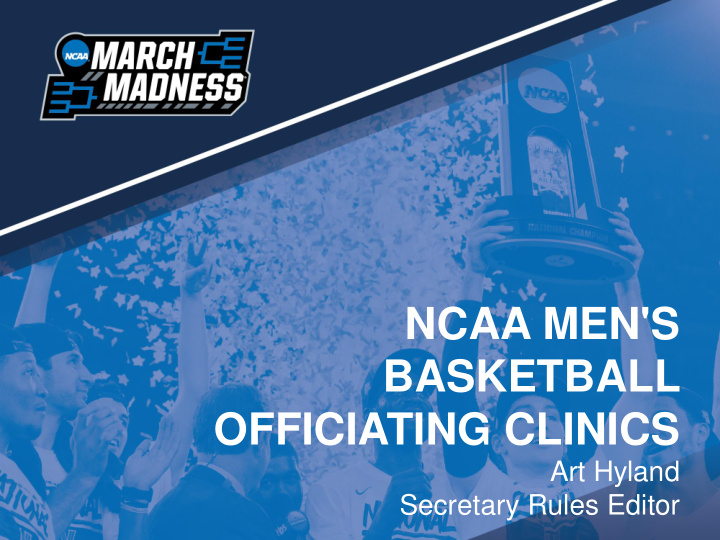



NCAA MEN'S BASKETBALL OFFICIATING CLINICS Art Hyland Secretary Rules Editor
May 2016 Rules Committee Meeting A. Non-rules change year. B. Reports from CCA coordinators and active official. C. Rules survey. D. Combined meetings with NABC Board and Division I Men’s Basketball Oversight Committee.
Rules Committee Action A. Potential Rules Changes for May 2017. B. Officiating Directive. 1. Continued improvement in reducing physicality in six main areas: hand checking/body bumping, post play, screening, defending players without the ball, rebounding and offense created contact. 2. Special attention to post play and rebounding situations. Traveling – especially on perimeter and in post. 3.
Rules Committee Action C. Coaches Calling Timeouts. 1. Not permissible during live ball. Exception : NEW – Throw-in before ball is released. 2. 3. Rationale: ball at far end of court; intent of rule was to eliminate timeouts when ball is on the court. Restricted Area – Revised Interpretation. D. Old Rule – Secondary defender may not establish initial legal 1. guarding position in RA for purpose of drawing a player control/charging foul regardless of the verticality rule.
Rules Committee Action 2. Restricted Area - NEW INTERPRETATION a. Legal defensive play when: 1) Secondary defender. Jumps straight up – verticality rule. 2) 3) Attempts to block shot. 4) Not applicable if defender remains grounded.
Rules Committee Action Verticality/Cylinder – Rule 4-38. E. 1. Verticality applies equally to the offense and defense. 2. Intent is to encourage the defense to back off the offensive player to allow for increased freedom of movement. Cylinder Dimensions – Buttocks, arms and legs, hands/arms on 3. front with bent elbows.
Rules Committee Action Verticality/Cylinder – Rule 4-38. (continued) E. It is a foul to cause illegal contact outside a player’s vertical 4. cylinder. 5. Offensive player must be given enough space to begin a “normal basketball play.” 6. Normal basketball play. a. Shooting. b. Dribbling. c. Passing.
Rules Committee Action Verticality/Cylinder – Rule 4-38. (continued) E. 7. Elbow contact – May not always be an offensive foul. a. Attempting normal basketball move. b. Defense invades offense cylinder. c. Offense moves ball from side to side with ball high (above shoulders). d. Offense moves ball from side to side with ball low (below waist). Ball at chest level – offense at risk for foul for attempting to e. clear space and cause illegal contact. Position of offensive player’s forearm – vertical vs. f. horizontal.
Review of A.R.s A.R.126: Try by A1- ball fails to touch rim/flange - A2 recovers and shot clock mistakenly reset – after time when original shot clock should have expired, B1 commits personal foul on A3 – official recognizes mistake. Ruling – Put correct time back on game clock, cancel foul, ball to Team B. (Rule 5-12.4).
Review of A.R.s A.R. 299: End of period – A1 fouled in act – game clock expires – A1 releases ball for successful/unsuccessful try. Successful – instant replay – foul before zeros: penalize 1. foul - time on game clock when foul occurred - count goal. Unsuccessful – instant replay – foul before zeros - 2. penalize foul - time on game clock when foul occurred.
Review of A.R.s A.R. 300: End of period – A1 fouled in act – shot clock expires – Immediately, A1 releases ball for successful/unsuccessful try and game clock horn sounds. Successful – instant replay – foul before zeros on shot 1. clock - penalize foul - time on game clock when foul occurred - count goal. Unsuccessful – instant replay – foul before zeros on shot 2. clock - penalize foul - time on game clock when foul occurred.
Recommend
More recommend